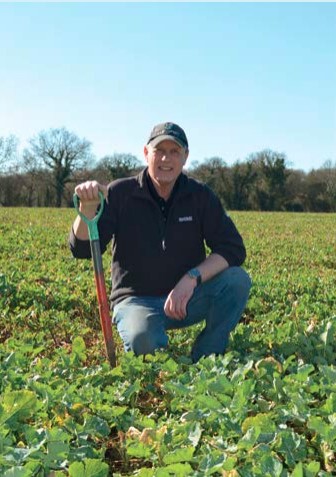Last autumn, the annual Agri-TechE REAP conference was held virtually, sharing technological ideas from people and companies innovating at the frontier of agriculture. The keynote speaker, supported by AHDB, at the event was David R. Montgomery, whose remit was to discuss how soil linked into the conference theme of “From micro-scape to landscape – innovating at the frontier”. David’s talk showcased how, when thinking about soils, we need to be looking at both of these scales.

An author and professor of geomorphology at the University of Washington, David has travelled the world to hear how farmers have reversed the fortunes of their soils. Numerous conversations later, he now believes soil-health nirvana can be achieved through the adoption of three general principles of conservation agriculture:
1. No or minimal soil disturbance to help soil life flourish
2. Growing ground cover to lock in nutrients and protect the land
3. Using a diverse rotation (three or more crops) to promote life and avoid nutrient over-extraction
The approach, alongside integrated pest management (IPM), provides an opportunity for farmers. However, as David concluded: “There is no ‘easy button’, when it comes to implementing regenerative farming”. Those who use their independence, intelligence and ingenuity to learn from their own experiences and those of others are most likely to thrive. One such farmer, David Miller of the Wheatsheaf Farming Company near Basingstoke, has worked with the three regenerative agricultural principles for decades – long before the term gained traction. A recent AHDB podcast featured machinery expert Harry Henderson, who discussed these principles with David and unearthed the secrets of the company’s success.
Regenerative agriculture in Hampshire
In the early 2000s, the company’s land was plagued with plateauing yields and rising costs. In 2010, the mission was to regain control of the soil and help it look after itself with minimum inputs. By working closer with nature, David wanted to bring back the feel-good element of farming. The 700 farmed hectares is situated mainly on grade 3 land, with drainage occurring naturally through the dominant chalky, stony and flinty soils.
Use of cover
They experimented with cover crops, starting with a single species (crimson clover), followed by a trial-and-error approach that now sees fairly diverse mixtures deployed. The mix is tailored to the situation (e.g. larger seed mixes used toward the end of autumn) with brassica species avoided – due to their bridging potential for slugs and diseases. They use species that succumb to frost, so the standing cover is not too thick and sucking up all the nutrition. They roll after any frost to tackle the remaining cover, although glyphosate is still needed for complete kill. By around 2014, all spring cereal crops followed an over-winter cover..

Minimal soil disturbance
The on-farm default for cultivation and establishment is minimal disturbance methods. However, the use of more disruptive forms of cultivation are used, when the situation demands it. For establishment, a cross-slot drill was purchased in 2015. Since then, the land has become easier to work – and the heavier cross-slot has gone, replaced by a more nimble disc-drill system. It is important to get the drill right at the start, David says. In the last five years, the choice and experience has exploded in the UK. It is important to explore the options and make the right choice for your system. Most straw on the farm is chopped at harvest and raked to even the distribution. As the soils are fairly resilient to compaction, self-restructuring, and all effort is made to avoid working the soil in suboptimal conditions, there is never the need to mechanically restructure them.
David has found that weeds now only tend to come up where the soil has been disturbed and what’s on the surface lose viability or are eaten by birds. However, the weed population has changed. Now there is less black-grass and more brome.
Rotational diversity
In addition to the use of cover crops, the cash crops in the rotation add diversity and flexibility, with a third of the land down to spring crops (barley and wheat). The winter crops include wheat, barley, oilseed rape, rye and, crucially, beans. Livestock are not a part of the system. Although they bring many benefits, they also bring risks, such as compaction in a bad winter.
Yielding success
With no blueprint available for regenerative agriculture in the UK, the sharing of locally relevant experiences is essential – and this is where our AHDB Monitor Farm and Strategic Farm networks come in. We are delighted to announce that David has been selected as AHDB’s fourth Strategic Cereal Farm, with the official launch in June 2021. The Strategic Farms promote the uptake of knowledge and provide a platform for farmers to explore new ideas that can have an impact on their business. David will represent the South, with Strategic Cereal Farms already established in Scotland, East and West.
David’s aim for the programme is to find a responsible pathway to reduce inputs. He said: “We are very pleased to have been chosen as the 4th AHDB Strategic Farm. Our vision for the next 6 years is to trial and prove various scenarios to ease the journey into regenerative agriculture. We aim to look at ways of quantifying the results of our actions in growing crops in a more biological way with less reliance on chemicals and inorganic fertilisers. The end result will, hopefully, give a reliable path of principles for others to follow.
